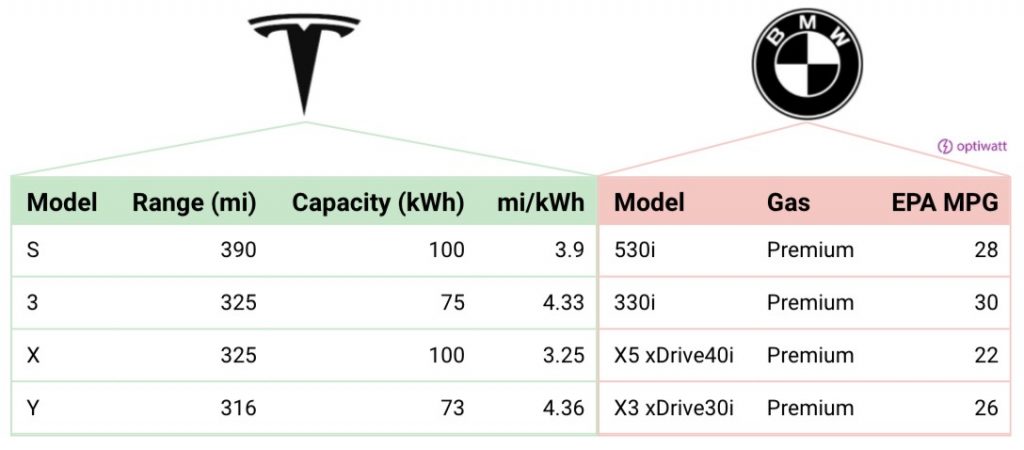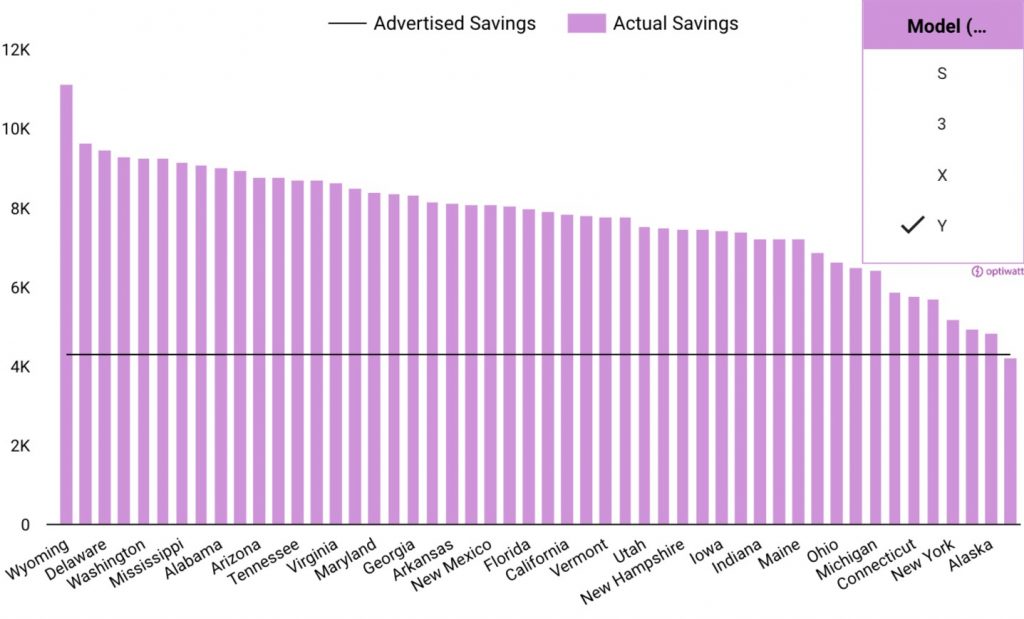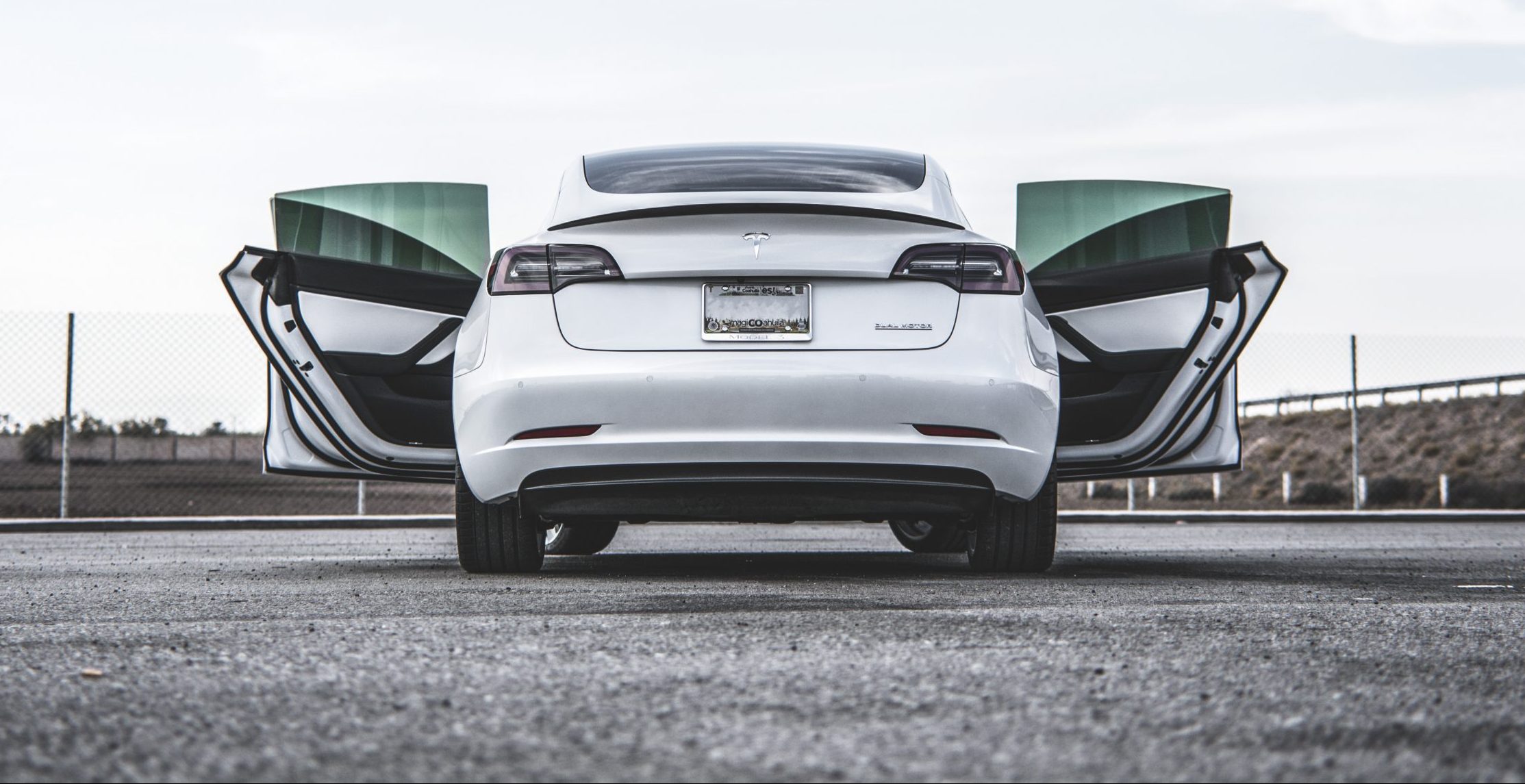Tesla’s online configurator for its electric cars primarily shows a price that’s adjusted for incentives and estimated fuel savings. These savings vary depending on the vehicle being ordered, with the company listing estimated gas savings of $4,300 for the Model 3 and Model Y, $5,300 for the Model X, and $5,500 for the Model S. These may seem like optimistic estimates, but as it turns out, these figures are actually conservative, at least for the majority of the United States.
Tesla’s fuel savings estimate is based on the premise that charging an all-electric vehicle is a lot more affordable than filling up the tank of a petrol-powered car. Looking at the company’s estimates, it appears that the listed fuel savings for the Model S, 3, X, and Y are based on the assumption that drivers would drive their Tesla for 10,000 miles annually for a period of six years. The costs of charging a Tesla over this period is then compared to the estimated costs of refueling a comparable vehicle, such as a BMW, with premium gasoline.
This strategy actually makes sense, considering that the all-electric construction of a Tesla will likely allow the vehicle to be used for at least six years. The comparison with BMW’s vehicles is quite sound as well, seeing as both companies offer premium cars that perform and compete in the same segment. That being said, EV charging rate monitoring service Optiwatt noted in a recent report that Tesla’s estimated gas savings are a lot more nuanced than what the company’s online configurator would suggest.

If there is one area where Tesla could be faulted, it is in the way that its estimated fuel savings for the US are the same regardless of the state where the car is being purchased. Different states have different electricity and average fuel prices, which means that there are some places where Tesla drivers could save more than the company’s own estimates, and areas where the opposite will be accurate. Take Hawaii, for example. The state pays 32 cents per kWh of electricity, which is over three times higher than the 9 cents per kWh that are paid by residents in Oklahoma.
Fuel consumption varies across states as well, with drivers in rural areas consuming more petrol and drivers in high-density states like New York consuming less. Wyoming drivers buy the most gas per capita at 609 gallons per person per year, while New York purchases less than half at 292 gallons per person per year. Considering that Tesla’s fuel savings rely on the price discrepancy between electricity and gas, owners who drive more are more likely to meet the company’s fuel savings estimates compared to owners who drive less.

Optiwatt’s analysis notes that ultimately, there are some areas in the United States where owning a Tesla will save drivers far more than what the company’s estimates would suggest, and there are some areas where fuel savings will be underwhelming. Driving a Model Y in Rhode Island for 10,000 miles every year for six years will save owners about $4,235 in fuel costs, which is a bit less than the company’s $4,300 estimate. Driving the all-electric crossover in Wyoming for six years, on the other hand, will give owners fuel savings of $11,122, over two times the company’s estimates.
A look at Optiwatt’s data shows that Tesla’s newer vehicles like the Model 3 and Model Y are more likely to meet the company’s fuel savings estimates, despite the Model S and Model X’s free Supercharging capabilities. Yet on average, across Tesla’s vehicle lineup, it appears that Americans can expect to save about $2,500 more than the company’s estimated savings over a six-year period. This bodes well for electric cars and their economic appeal as a whole. After all, a Tesla is not just designed to run for 6 years. With the company’s million-mile batteries poised to be released soon, Tesla drivers over the years will likely see even more fuel savings for every electric car purchase.
News
Tesla launches in India with Model Y, showing pricing will be biggest challenge
Tesla finally got its Model Y launched in India, but it will surely come at a price for consumers.

Tesla has officially launched in India following years of delays, as it brought its Model Y to the market for the first time on Tuesday.
However, the launch showed that pricing is going to be its biggest challenge. The all-electric Model Y is priced significantly higher than in other major markets in which Tesla operates.
On Tuesday, Tesla’s Model Y went up for sale for 59,89,000 rupees for the Rear-Wheel Drive configuration, while the Long Range Rear-Wheel Drive was priced at 67,89,000.
This equates to $69,686 for the RWD and $78,994 for the Long Range RWD, a substantial markup compared to what these cars sell for in the United States.
🚨 Here’s the difference in price for the Tesla Model Y in the U.S. compared to India.
🚨 59,89,000 is $69,686
🚨 67,89,000 is $78,994 pic.twitter.com/7EUzyWLcED— TESLARATI (@Teslarati) July 15, 2025
Deliveries are currently scheduled for the third quarter, and it will be interesting to see how many units they can sell in the market at this price point.
The price includes tariffs and additional fees that are applied by the Indian government, which has aimed to work with foreign automakers to come to terms on lower duties that increase vehicle cost.
Tesla Model Y seen testing under wraps in India ahead of launch
There is a chance that these duties will be removed, which would create a more stable and affordable pricing model for Tesla in the future. President Trump and Indian Prime Minister Narendra Modi continue to iron out those details.
Maharashtra Chief Minister Devendra Fadnavis said to reporters outside the company’s new outlet in the region (via Reuters):
“In the future, we wish to see R&D and manufacturing done in India, and I am sure at an appropriate stage, Tesla will think about it.”
It appears to be eerily similar to the same “game of chicken” Tesla played with Indian government officials for the past few years. Tesla has always wanted to enter India, but was unable to do so due to these import duties.
India wanted Tesla to commit to building a Gigafactory in the country, but Tesla wanted to test demand first.
It seems this could be that demand test, and the duties are going to have a significant impact on what demand will actually be.
Elon Musk
Tesla ups Robotaxi fare price to another comical figure with service area expansion
Tesla upped its fare price for a Robotaxi ride from $4.20 to, you guessed it, $6.90.

Tesla has upped its fare price for the Robotaxi platform in Austin for the first time since its launch on June 22. The increase came on the same day that Tesla expanded its Service Area for the Robotaxi ride-hailing service, offering rides to a broader portion of the city.
The price is up from $4.20, a figure that many Tesla fans will find amusing, considering CEO Elon Musk has used that number, as well as ’69,’ as a light-hearted attempt at comedy over the past several years.
Musk confirmed yesterday that Tesla would up the price per ride from that $4.20 point to $6.90. Are we really surprised that is what the company decided on, as the expansion of the Service Area also took effect on Monday?
But the price is now a princely $6.90, as foretold in the prophecy 😂
— Elon Musk (@elonmusk) July 14, 2025
The Service Area expansion was also somewhat of a joke too, especially considering the shape of the new region where the driverless service can travel.
I wrote yesterday about how it might be funny, but in reality, it is more of a message to competitors that Tesla can expand in Austin wherever it wants at any time.
Tesla’s Robotaxi expansion wasn’t a joke, it was a warning to competitors
It was only a matter of time before the Robotaxi platform would subject riders to a higher, flat fee for a ride. This is primarily due to two reasons: the size of the access program is increasing, and, more importantly, the service area is expanding in size.
Tesla has already surpassed Waymo in Austin in terms of its service area, which is roughly five square miles larger. Waymo launched driverless rides to the public back in March, while Tesla’s just became available to a small group in June. Tesla has already expanded it, allowing new members to hail a ride from a driverless Model Y nearly every day.
The Robotaxi app is also becoming more robust as Tesla is adding new features with updates. It has already been updated on two occasions, with the most recent improvements being rolled out yesterday.
Tesla updates Robotaxi app with several big changes, including wider service area
News
Tesla Model Y and Model 3 dominate U.S. EV sales despite headwinds
Tesla’s two mainstream vehicles accounted for more than 40% of all EVs sold in the United States in Q2 2025.

Tesla’s Model Y and Model 3 remained the top-selling electric vehicles in the U.S. during Q2 2025, even as the broader EV market dipped 6.3% year-over-year.
The Model Y logged 86,120 units sold, followed by the Model 3 at 48,803. This means that Tesla’s two mainstream vehicles accounted for 43% of all EVs sold in the United States during the second quarter, as per data from Cox Automotive.
Tesla leads amid tax credit uncertainty and a tough first half
Tesla’s performance in Q2 is notable given a series of hurdles earlier in the year. The company temporarily paused Model Y deliveries in Q1 as it transitioned to the production of the new Model Y, and its retail presence was hit by protests and vandalism tied to political backlash against CEO Elon Musk. The fallout carried into Q2, yet Tesla’s two mass-market vehicles still outsold the next eight EVs combined.
Q2 marked just the third-ever YoY decline in quarterly EV sales, totaling 310,839 units. Electric vehicle sales, however, were still up 4.9% from Q1 and reached a record 607,089 units in the first half of 2025. Analysts also expect a surge in Q3 as buyers rush to qualify for federal EV tax credits before they expire on October 1, Cox Automotive noted in a post.
Legacy rivals gain ground, but Tesla holds its commanding lead
General Motors more than doubled its EV volume in the first half of 2025, selling over 78,000 units and boosting its EV market share to 12.9%. Chevrolet became the second-best-selling EV brand, pushing GM past Ford and Hyundai. Tesla, however, still retained a commanding 44.7% electric vehicle market share despite a 12% drop in in Q2 revenue, following a decline of almost 9% in Q1.
Incentives reached record highs in Q2, averaging 14.8% of transaction prices, roughly $8,500 per vehicle. As government support winds down, the used EV market is also gaining momentum, with over 100,000 used EVs sold in Q2.
Q2 2025 Kelley Blue Book EV Sales Report by Simon Alvarez on Scribd
-

 News3 days ago
News3 days agoTesla debuts hands-free Grok AI with update 2025.26: What you need to know
-

 Elon Musk1 week ago
Elon Musk1 week agoElon Musk confirms Grok 4 launch on July 9 with livestream event
-

 Elon Musk5 days ago
Elon Musk5 days agoxAI launches Grok 4 with new $300/month SuperGrok Heavy subscription
-

 News2 weeks ago
News2 weeks agoTesla Model 3 ranks as the safest new car in Europe for 2025, per Euro NCAP tests
-

 Elon Musk2 weeks ago
Elon Musk2 weeks agoxAI’s Memphis data center receives air permit despite community criticism
-

 News5 days ago
News5 days agoTesla begins Robotaxi certification push in Arizona: report
-

 Elon Musk2 weeks ago
Elon Musk2 weeks agoTesla reveals it is using AI to make factories more sustainable: here’s how
-

 Elon Musk2 weeks ago
Elon Musk2 weeks agoTesla scrambles after Musk sidekick exit, CEO takes over sales














